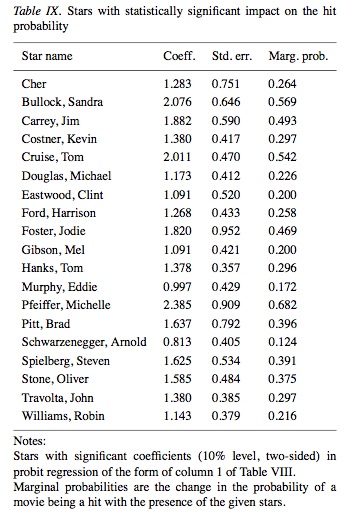Congratulations! If you work in the entertainment industry, you are statistically more likely to make it big than in a regular field. Of course, you’re also more likely to completely fail. Welcome to the magic of living and working in a kurtotic system.
This news comes courtesy of the absolutely-fascinating-every-single-one-of-you-should-read-it book Hollywood Economics, by Arthur De Vany. I’m not a statistician (as you’ll obviously see), but De Vany is, and the book is full of brute force statistic analysis of different aspects of the entertainment industry, including “does having a star in your movie guarantee box office?” “is the blockbuster strategy successful?” and “does luck or talent predict a strong career in the industry?” (that last one should be of interest to pretty much everybody). Now, as an anthropologist, I am loathe to rely on strictly statistical analysis of what are clearly strongly culturally-determined effects, but DeVany’s data is compelling. Statistics can’t give you an idea of the cultural reasons behind the effects they’re showing, but they are good for measuring those effects.
One of the most interesting overall conclusions De Vany makes is that analyses of almost all Hollywood functions reveal that the entertainment industry is, statistically speaking, highly kurtotic (as opposed to having a standard, bell-curve-like distribution). That means that the industry is characterized by a non-standard distribution curve of resources, and is highly sensitive to nonlinear event cascades: so exceptional statistical values, both high and low, occur more frequently than in normally structured systems.

Different statistical curves – note that high kurtosis (technically called “leptokurtic” here) has an unusually high peak, but also that the downslopes of the peak are lower than in a standard distribution. I know, statistics make my head hurt, too.
In other words, there is an unusually large proportion of people at the bottom, and that people at the top are really at the top. And as a side benefit, seemingly small events can snowball into large outcomes more frequently than in a standard system (for example, you write a small screenplay for a webisode, someone likes it, they offer you to write an episode of a TV show, you get bigger and bigger screenwriting jobs, and eventually you’re a well-known, powerhouse screenwriter (?), being yelled at by Mel Gibson – all originating from a single, small event). Now, things like this can certainly happen in a regular system, but in a kurtotic one, they’re more likely to happen.
That’s right, in a system of high kurtosis, extreme values occur more often than in a regular system. As De Vany notes, the Hollywood system is “dominated by a handful of extraordinary movies and artists that account for nearly all of the industry impact and revenue. The kurtocrats are Hollywood’s elite, the actors, directors, writers, and producers who are associated with the major movies.”
Figures do indeed bear this out. According to the MPAA, in 2010 the entertainment industry was responsible for $16 billion in wages in the state of California. The top ten earning actors that year made $349 million of the total $16 billion in wages – meaning 2% of the total wages were earned by roughly .0038% of the workforce. But we shouldn’t forget that there are 121,990 more actors out there; DeVany is correct about the kurtotic nature of the industry, but his analysis creates an unreasonable focus on the super-elites in the system, while ignoring the vast number of middle-class, working stiffs.

One of De Vany’s graphs, showing the effect of having big-name stars in a movie. From the names, you can tell this article was written in 1999. (full citation below)
A system of high kurtosis means a lot of high values, but a lot of extremely low ones as well – all the people you know or have met that are trying to make it for many years, or exist on the fringes of the industry. But hey, look at the bright side: a nonlinear event cascade could mean that any one of those people could (relatively) suddenly be unbelievably successful. In fact, the rise of the original studio heads is an excellent example of this; and it’s arguably part of the dream that has kept people coming to L.A. since the biz began.
— Scott Frank
- Table from “Uncertainty in the Movie Industry: Does Star Power Reduce the Terror of the Box Office?” by Arthur De Vany and W. David Walls, Journal of Cultural Economics, 23: 284-318, 1999.
- By the way, as an anthropologist and not a statistician, my grasp of these concepts is admittedly weak. I’m going mostly by my reading of what De Vany writes, and will welcome corrections from people with a deeper understanding of statistics than myself.



